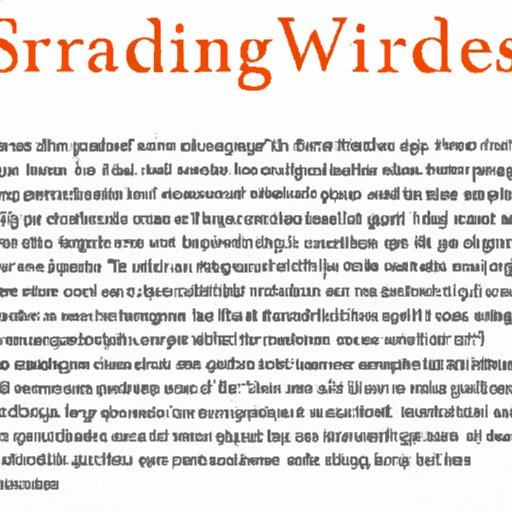Introduction
Writing style is a form of expression that can be used to communicate ideas, opinions, and emotions. It is the way an author chooses to present their written work to the reader. Writing style is an important tool in conveying messages and can be used to give an individual’s work its own unique flavor.
This article seeks to explore what writing style is, different types of writing styles, and tips on how to create your own unique writing style. We will also look at common mistakes to avoid when developing your writing style.
Defining Writing Style: What It Is and How to Use It
Writing style is the combination of word choice, sentence structure, syntax, punctuation, and other elements that make up how an author communicates their message. It is not just about being grammatically correct, but rather about finding the most effective way to get your point across.
There are many different types of writing styles, each with its own purpose and audience. Academic writing is used for scholarly articles, research papers, and textbooks. Creative writing is used for fiction stories, poems, and plays. Business writing is used for emails, memos, and reports. Technical writing is used for instruction manuals, user guides, and software documentation.
Developing your own unique writing style will help you stand out from the crowd and make your work memorable. It can also help you convey your message more clearly and effectively. Here are some tips for improving your writing style:

Exploring Different Types of Writing Style and Their Uses
Academic Writing: Academic writing is used for scholarly articles, research papers, and textbooks. It is formal and objective in nature, and usually follows a specific writing format. The goal of academic writing is to provide a clear, concise, and well-reasoned argument.
Creative Writing: Creative writing is used for fiction stories, poems, and plays. It is often more descriptive and emotive than other types of writing, allowing the writer to express their personal feelings or opinions. The goal of creative writing is to create a vivid picture in the reader’s mind and evoke emotion.
Business Writing: Business writing is used for emails, memos, and reports. It is typically more formal than other types of writing, as it is used to convey information and ideas in a professional manner. The goal of business writing is to convey information in a clear and concise manner.
Technical Writing: Technical writing is used for instruction manuals, user guides, and software documentation. It is used to explain complex topics in a simple and straightforward manner. The goal of technical writing is to provide clear and accurate instructions.

Crafting a Unique Writing Style for Maximum Impact
Once you have a better understanding of the different types of writing styles and their uses, you can begin to craft your own unique writing style. Here are some tips for improving your writing style:
- Be aware of your audience – who are you writing for and what do they expect from your writing?
- Use a consistent writing voice – decide on a writing style and stick with it.
- Pay attention to word choice – use words that are appropriate for your audience and that convey your message clearly and effectively.
- Vary sentence structure – using a variety of sentence lengths and structures will keep your writing interesting and engaging.
- Edit and proofread your work – take the time to go over your work and make sure it is free of errors.
Understanding the power of word choice in writing style is key to crafting a unique writing style. Think carefully about the words you choose and how they can best convey your message. Avoid using overly technical language or jargon that may confuse your readers.
When developing your writing style, it is also important to avoid making common mistakes. These include:
- Using too much passive voice – active voice is more direct and engaging.
- Being too wordy – try to be succinct and get to the point quickly.
- Using clichés – avoid using phrases that have been overused and are no longer meaningful.
- Ignoring grammar rules – pay attention to grammar and punctuation rules to ensure your writing is clear and easy to understand.
Conclusion
In conclusion, writing style is an important tool in conveying messages effectively. There are many different types of writing styles, each with its own purpose and audience. Developing your own unique writing style will help you stand out from the crowd and make your work memorable.
By understanding the power of word choice in writing style and avoiding common mistakes, you can craft a writing style that is both unique and effective.
(Note: Is this article not meeting your expectations? Do you have knowledge or insights to share? Unlock new opportunities and expand your reach by joining our authors team. Click Registration to join us and share your expertise with our readers.)
